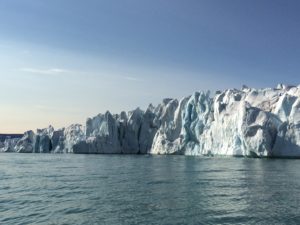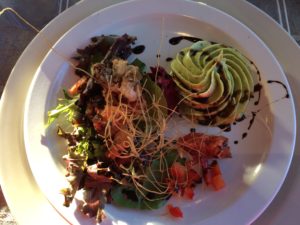Aug. 16, 2017
Each day on the Canada C3 journey brings another set of remarkable adventures, and our third day was no exception! We continued our trip through Lancaster Sound to Dundas Harbour on Devon Island. A former RCMP and Hudson’s Bay trading post, we heard a touching story from Jena Merkosak of Pond Inlet, about her grandmother’s birth in this area. As part of the programming on board, I was honoured to give a presentation on my own research in the area of environmental art activism, connecting to the C3 themes of Environment and Youth Engagement. Charlene followed this with a moving presentation on residential schools and Project Heart, a community arts project that honours residential school survivors. As someone of European ancestry, coming to terms with the intergenerational trauma caused by colonialism is difficult but necessary part of the process of reconciliation. I appreciate Charlene’s perspective in this: there is “nothing helpful in guilting white people, or in re-traumautizing indigenous people” in this process, but “we all have to take the responsibility to teach the truth; we are all teachers.”  Figuring out who the right teachers are for different parts of this process is an ongoing conversation in our group.
The afternoon found us arriving in the spectacular beauty of Croker Bay on Devon Island. It contains a huge glacial valley, reaching down to the sea at the Bay. I found myself in a zodiac with experienced guide Jean Castonguay, sea ice expert Tom Zagon, and new Canadian Valerii Dombrovskyi. With Jean doing the driving, we had the ice walls of the Devon Island Ice Cap to ourselves for an hour while the others hiked on top of it. The glacier is a stunning sight, with nature proving itself to be a skilled sculptor of ice, snow, and water; shades of white, grey and blue can be found on its multiple faces, crevices and gullies. As we cruised along its length, we passed by many bergie bits and growlers (different sizes of sea ice), reaching out to touch their smooth surfaces as they floated by.  I got a chance to try painting with pieces of teh glacier on the beach next – one of the ways I’m trying to capture the journey artistically.  A hike on the top of the glacier followed, with my first taste of the purity of glacial water. During this visit we were captivated by the beauty of the glacier, yet we struggled with the knowledge that it is melting quickly due to human-induced climate change, along with other parts of the polar ice cap. I worry deeply about the effects of this, and it forms in part the impetus for my own work in Environmental & Sustainability Education.
As if the day couldn’t get any better, in the evening we found ourselves on the hangar for a special dinner prepared by chef Matt Krizan from Mahone Bay, NS. With a view of the glacier out the back, and Matt’s broad grin presenting us a fabulous meal (how did he do this in a ship’s galley?!), we toasted how lucky we are to see these beautiful parts of Canada that few get to see. If more could see them, would everyone work towards better addressing climate change? How will I change to do this in my own life?
Note: Not surprisingly, wifi is proving to be elusive at times. I am writing posts daily but sometimes having a hard time getting internet access to post them – please be patient as I get caught up.
 Â Â Â Â Â Â
      



